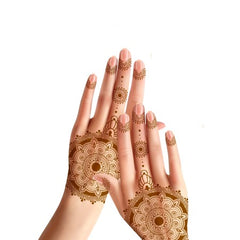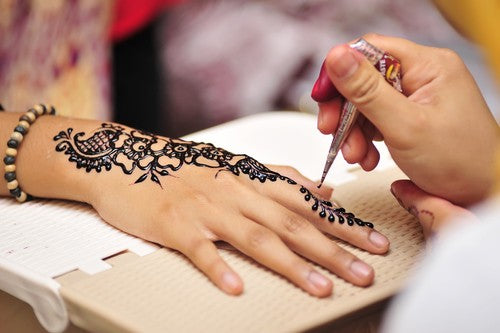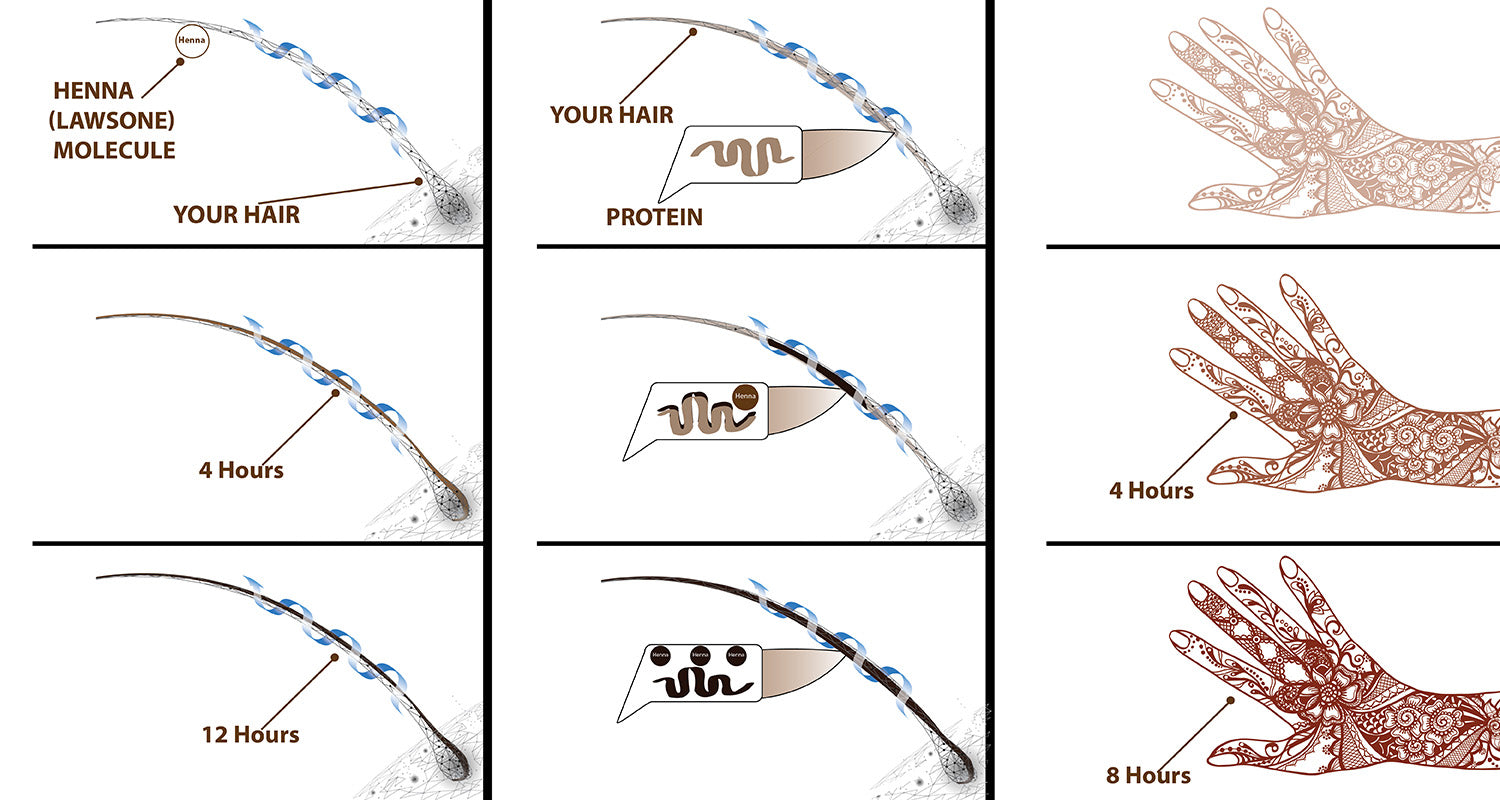Henna (Lawsonia inermis) is a plant-based dye created from the henna tree, also known as Egyptian privet, and mignonette tree. The leaves of the henna plant contain a natural coloring pigment that is used for temporary body art, coloring hair, dye skin, fingernails as well as fabrics such as leather, wool, and silk.

Henna has been used in Ancient Egypt as well as other tropical regions including North America, South Asia, the Arabian Peninsula, and some parts of Africa. Nowadays, the plant is more spread in the hot climates of Australia, Pakistan, and India.
The Henna Plant

Henna is a flowering plant that grows best in a warm climate of up to 120F degrees. Inversely, the henna plant also grows in temperatures below 50F degrees.
The pigment color varies in each tropical region and the sizes of the plant as well by approximately 2-3 cm in height. The henna plant contains an active compound "lawsone", which is an orange-reddish dye that binds with keratin (a protein) in our skin to stain it.
The stain of the henna varies from deep burgundy to pale orange depending on the quality of the leaves and what mixture you used to make the henna paste. Henna grown in hot and dry weather will stain the best.
Henna Powder Mixture
The whole henna leaves will not stain your skin, as long as the Lawsone molecule doesn't attract with the keratin. Thus, the henna leaves are dried into powder form and then utilized into a mashed paste.

Using this way, the lawsone molecule gradually migrates from the henna paste into the outer lair of your skin, creating a stain of your choice.
Since it is difficult to make body art from leaves, henna is widely available in powder form, made by drying and sifting the leaves. The dry powder is then mixed with liquids, including water, coffee, lemon juice, and other ingredients.
The henna mixture must rest for a short period of time before applying it to your skin. Depending on the leaves of the henna, using essential oil such as Lavender, or tea tree will also improve the stain of the dye. Natural henna paste is not shelf-stable, meaning that it will expire and shouldn't be left on a shelf for over one week.
Wedding Tradition and Eid Celebration

Henna is widely used on special occasions like weddings, holidays, and birthday parties in India, Pakistan, Africa, and the Middle East. The most popular tradition is the Mehndi Night where the bride, her family, and friends celebrate together by using different mehndi (henna) designs.
The night is filled with other celebrations and performance that is considered to bring the families closer.
Another major celebration is the Eid holiday, celebrated by Muslims around the world. At the end of the Month Ramadhan, Muslim women decorate their hands with henna tattoo designs and celebrate the 3-day holiday of Eid-ul-Fitr with their friends and family.
The occasion is celebrated by a big brunch followed by a family get-together and gift distribution. Henna only stains the skin in a variation of brownish or reddish as per the quality of the powder or your DIY mixture method - At full majority, the stain of the paste lasts for around 4 days to two weeks.

Areas such as your feet, soles, and palms will stain the darkest as they are not so much washed. Also, henna body design on the abdominal and back will last the same.
Henna Hair Dye
Henna is a natural permanent hair dye that is widely used around the world for its numerous hair benefits. Starting from the basic, it is a fresh and natural hair dye, free from value-added chemicals. Henna hair coloring dates thousands of years back into the early Ancient Egypt and Nefertiti civilization.

Because it is a natural alternative to traditional-based dye, it is also used to dye eyebrows, mustache, and beard. As the grown trend of natural products, henna is more popular than ever in the west. It not just makes your hair stronger but also treats dull and damaged hair because of its earthly benefits.

Unlike conventional-based dye, there's not much of the coloring you can achieve with henna. Also, the application process is longer compared to the henna body art.
The henna (Lawsone) Molecule takes a lot of time in the bounding process to attract your hair protein. Although the amount varies by person and the powder you're using, a typical henna hair dye process can take anywhere from 15 to 24 hours. First, you have to let the mixture rest for about 8 hours. Then let it sit on your hair for additional 4-10 hours.
The Lawsonia pigment molecule will bind on your hair and over time will improve its hair texture. As the color fusion peaks, more and more molecules will interact with your hair, resulting in perfect natural hair color.
Benefits of using Henna for Hair
- It gives a natural color to your hair with a light red blonde to the orange hair tone
- It strengthens your hair and prevent breakage
- It makes your hair lustrous and shiny
- Its anti-parasitic and anti-fungal properties treats scalp dandruff
- It softens your hair and improves the elasticity
- It rejuvenated dull, damaged, and dry hair
Disadvantage of henna for hair
- Not all-natural products are suitable for everyone. It is best to do a patch test prior to the application
- Henna is a permanent hair dye and doesn't fade off quickly
- The application process is a bit longer compared to box hair dye
- Unless used with other natural herbs like indigo and amla, henna on its own is reddish-orange dye

Variation of Henna
In general, there are 3 varieties of henna available.
- Natural Henna
Natural Henna (Lawsonia inermis) produces a rich brown-red stain when it is first applied and will last for about a week on your skin. It is pure henna made from the leaves of the Lawsonia plant.
- Neutral Henna
Neutral henna (Cassia Obovata) is not pure henna powder. In fact, it is a totally different plant called Senna Italica. Both natural and neutral henna plants look alike but their properties and molecular consistency vary. Neutral henna on its own does not change your hair color.
- Black Henna
Black henna is a completely different thing, derived from Indigo, natural henna, and other unlisted dyes or chemicals such as para-phenylenediamine (PPD). This dye is mostly used to color fabric but as it has a more darkish color, it is being used by manufacturers to create henna tattoo cones and hair dye.
FDA specifically forbids PPD to be used for skin and hair products. Uses of black henna can lead to severe allergic reactions and scarring.
Henna Distribution Today
Today, commercially packaged henna, intended for the use of cosmetics is available around the world. A lot of manufacturers mix pure henna powder with other herbs to make color shades of auburn, brown, burgundy, and even jet-black color.
However, the color mixture of other henna shades is called a 2-step process. Mainly because on the first turn you have to apply henna and on the second turn, some other herbal powder. Henna is also used in other cosmetic products such as perfumes, soaps, and shampoo.
Still henna-curious? Read out these frequently asked questions or check our henna collection page.
Read out these frequently asked questions or check our henna collection page.
Frequently asked questions
Is henna illegal in the US?
Henna hair dye is completely allowed in the US, the only unapproved form is the henna body paste. The reason is the frequent adulteration of this natural dye that can cause skin irritations. Note that henna is not yet approved by the FDA. This doesn’t mean it’s illegal to use.
Is henna religious or cultural?
Henna application is both a cultural and religious act. Muslims, Hindus, Sikhs, and Buddhists around the world have their religious values attached to it. It is also a part of Middle East and Asian culture where henna is applied to festivals.
Can I get black or another color from the Henna tattoo?
The original henna paste gives an orange to reddish hue. You can mix other natural ingredients like beetroot powder, etc. to make it darker. It is still not possible to get black henna tattoos unless you use the unsafe black henna.
What are the disadvantages of henna?
It is hard to find 100% organic henna these days. Most products are altered with chemicals, like black henna. Using these products can be harmful for your skin and scalp.
